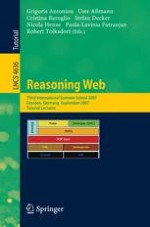2007 | Book
Reasoning Web
Third International Summer School 2007, Dresden, Germany, September 3-7, 2007, Tutorial Lectures
Editors: Grigoris Antoniou, Uwe Aßmann, Cristina Baroglio, Stefan Decker, Nicola Henze, Paula-Lavinia Patranjan, Robert Tolksdorf
Publisher: Springer Berlin Heidelberg
Book Series : Lecture Notes in Computer Science

